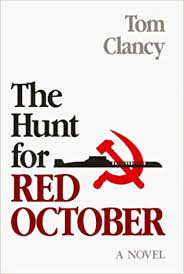On October 1, 2013 Tom Clancy died. So in honor of that anniversary earlier this month I am writing a short retrospective on his past work and his ever growing oeuvre. In the main Tom Clancy is certainly a hack and despite that is still one of the most impactful writers of the 20th century.

Tom Clancy helped to shape the public face of the United States Military, history, and political discourse in a way that does not register with most of us consciously. His works disseminated and cemented a picture of the United States and it’s armed forces that prevails to this day. This can be attested to not just by the blockbuster movies, the video games that bear his name, and the books he continues to author almost a decade after his death. Tom Clancy represents a mode of production of art objects that is completely militarized and highlights the way the pentagon has come to integrate art objects into it’s arsenal. Clancy’s innovation was how he sought to emulate the doctrine of US military. Clancy was brilliant because his thoughts were so closely aligned with that of his subject that it becomes difficult to tell what is the line of the military and what is Clancy’s own contributions. Certainly, this is true in the case of Clancy’s break out novel The Hunt For Red October (1984) Clancy was just another white man steeped in a military culture, and immersed in the anxieties of high cold war orthodoxy. He never served in the active military, I do not say this to discredit him, but rather to show him as an outsider to the US military. To the best of my knowledge while writing The Hunt for Red October Clancy did not enjoy the access to the US military, its arms industry boosters and intellectual vanguard that he would quickly developed in his career.
Clancy represented a concise description of what Americans were concerned about at the time, he harnessed the explicit and implicit messages in his environment and reverse engineered those messages into a narrative that captured the imagination of hot blooded young men, and caught the attention of generals. The Hunt for Red October is essentially the story of Reaganite Mutually Assured Destruction or MAD. This notion operated in the vein of Nixon’s mad man thesis, bolstered with the mathematics of the Nash Equilibrium the pseudoscience of economist Leopold Von Missil. In other words the system could work as long as, as one side never developed the capacity to destroy the other without the fear of retribution. Now for those of us looking back on the cold war 30 years hence we know that internally the US felt exceedingly confident in it’s Nuclear edge. This confidence is, in hindsight, a vast underestimation. Revelations from declassified documents during the Glasnost era showed the Soviet Union’s profound unwillingness and under preparedness to initiate or return atomic weapons fire. The Soviet leaderships wanted stability and was for the most part disinterest in any attempt to initiate an arms race. This may be a better explanation for the aversion of nuclear war, rather than the dominant narrative that the world was spared by daring US brinksmanship. Despite this truth the fear of a Soviet nuclear weapons gap was an ongoing concern for the American public. As long as the public was afraid of the Soviets the Pentagon hand social license to grow it’s power and funding, and they were bringing their friends in the defense industry with them. Evidently Mr. Clancy felt this same paranoia because he eloquently painted a picture of a Soviet threat in totally American terms. He was worried about a Soviet stealth sub. A device that was not a Soviet invention but that mirrored the Strategic ambition of the Pentagon, and it was a technology they were actively searching for.
The decision to have a Soviet Stealth Sub with a renegade captain is an especially egregious example, because the atomic weapon armed submarine was the cornerstone of the American nuclear threat and deterrence. A Submarine could hide under arctic or sub arctic ice for months, and launch a preemptive attack from close to soviet territory or retaliate even if the entire US was annihilated. The Soviet plan for nuclear deployment mainly relied on long ranged missiles launched from trucks or trains. This is not to say the the Soviet Union did not peruse naval based atomic weapons, but they did not produce and deploy them on nearly the scale of American forces, largely because the US had another technological edge.
The US protected itself from a naval strategy with an elaborate deep sea sensor net. This emboldened US aggression, because it allowed the US to threaten the Soviets, without fear of symmetrical reprisal. The pentagon rightly understood the terror they had imposed on the USSR and understandably feared the possibility that it would be reversed on them. The idea of a silent submarine was, in 1984, and is a center piece of defense journalists even to this day, and it remains a talking point in the resurgence of nuclear tensions with the Russian Federation. So Clancy was not inventing any of these concepts, but rather taking the public talking points of the national security apparatus and rendering them into a consumable narrative devoid of any of the complexities, and contradictions these actions had in the real world. Tom Clancy wrote a story about them imminent need for nuclear aggression with US rivals, in which the the principle antagonist was the Soviets, behaving as Americans were acting towards the Soviets. This idea was disseminated to millions of people through a best selling book, and a popular film.
The Hunt for Red October was successful because it created multiple synergies with other industries, public relations agendas, and appeared to have legitimacy as it meticulously mirrored official pentagon talking points. The public devoured it, because it confirmed their biases. Despite being a rehashing of what the new reading public was told told everyday it presented itself as a look behind the curtain into the the secret technology and classified history of the military industrial complex. This is why Clancy is important because The Hunt for Red October and his other books demonstrates his talent for shaping abstract prejudices and anxieties into concise narratives and filtering them through a propagandistic discourse into the world of Jack Ryan.
Jack Ryan is the central character of the Clancyverse, who has thrice been played by people magazines sexiest man alive, and who in the details of his life represents the perfect trifecta of American power interests: Wall Street, The Pentagon/CIA, and Capitol Hill. The Jack character is a brilliant finance market speculator, a veteran who made it rich on Wall Street despite his modest providence, before going into intelligence work, and who later became vice president and then president of the US. If you replace his respectable white middle class background, with a family of financiers and oil barons you have… Georg H. Bush’s (The first one) career path from veteran, tycoon, CIA director, Vice President, President. I feel it also is worth mentioning that Jack becomes president after the Japanese fly a highjacked jetliner into the congress killing the president during the State of the Union Speech, in his 1996 book Debt of Honor. Of course it was an error, of the ever culturally sensitive Clancy, to accuse the Japanese of something so reminiscent of World War II(more on that later.). The richness of how the hopes and fears of the security state play themselves out sometimes years ahead of them shaping policy decisions or the security landscape, as in the case with suicide plane-jacking. Because what Clancy had done to support the navy was only the beginning as Clancy progresses to his next client. The US State department.
To be continued next week

One Reply to “Clancy’s War Part 1”